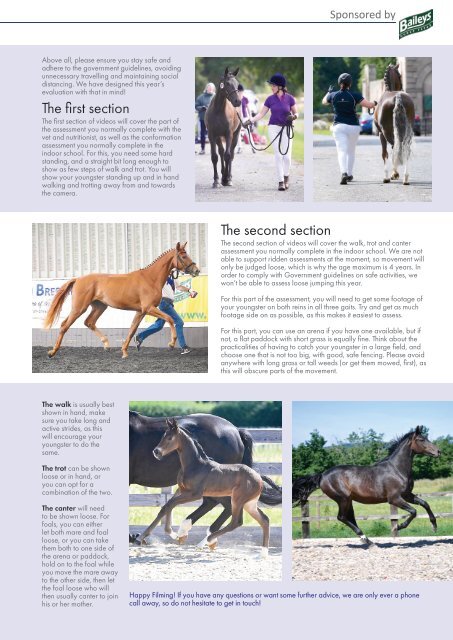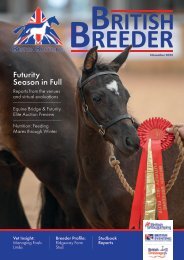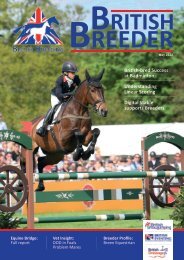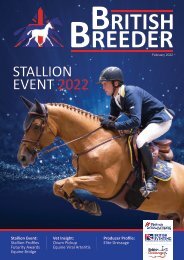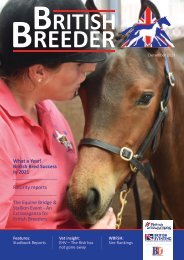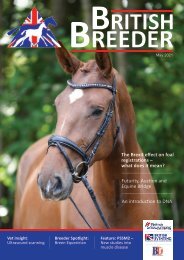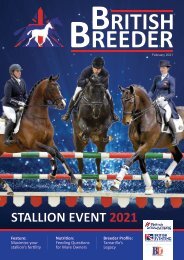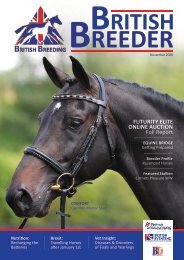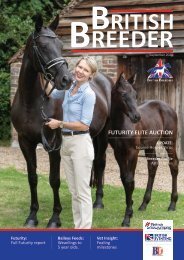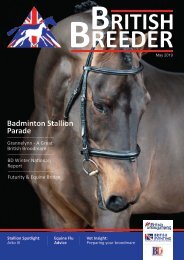British Breeder Magazine May 2020
Magazine for breeders of British bred sport horses. Includes breeding industry news, updates, interviews, profiles and reports.
Magazine for breeders of British bred sport horses. Includes breeding industry news, updates, interviews, profiles and reports.
You also want an ePaper? Increase the reach of your titles
YUMPU automatically turns print PDFs into web optimized ePapers that Google loves.
Sponsored by<br />
Above all, please ensure you stay safe and<br />
adhere to the government guidelines, avoiding<br />
unnecessary travelling and maintaining social<br />
distancing. We have designed this year’s<br />
evaluation with that in mind!<br />
The first section<br />
The first section of videos will cover the part of<br />
the assessment you normally complete with the<br />
vet and nutritionist, as well as the conformation<br />
assessment you normally complete in the<br />
indoor school. For this, you need some hard<br />
standing, and a straight bit long enough to<br />
show as few steps of walk and trot. You will<br />
show your youngster standing up and in hand<br />
walking and trotting away from and towards<br />
the camera.<br />
The second section<br />
The second section of videos will cover the walk, trot and canter<br />
assessment you normally complete in the indoor school. We are not<br />
able to support ridden assessments at the moment, so movement will<br />
only be judged loose, which is why the age maximum is 4 years. In<br />
order to comply with Government guidelines on safe activities, we<br />
won’t be able to assess loose jumping this year.<br />
For this part of the assessment, you will need to get some footage of<br />
your youngster on both reins in all three gaits. Try and get as much<br />
footage side on as possible, as this makes it easiest to assess.<br />
For this part, you can use an arena if you have one available, but if<br />
not, a flat paddock with short grass is equally fine. Think about the<br />
practicalities of having to catch your youngster in a large field, and<br />
choose one that is not too big, with good, safe fencing. Please avoid<br />
anywhere with long grass or tall weeds (or get them mowed, first), as<br />
this will obscure parts of the movement.<br />
The walk is usually best<br />
shown in hand, make<br />
sure you take long and<br />
active strides, as this<br />
will encourage your<br />
youngster to do the<br />
same.<br />
The trot can be shown<br />
loose or in hand, or<br />
you can opt for a<br />
combination of the two.<br />
The canter will need<br />
to be shown loose. For<br />
foals, you can either<br />
let both mare and foal<br />
loose, or you can take<br />
them both to one side of<br />
the arena or paddock,<br />
hold on to the foal while<br />
you move the mare away<br />
to the other side, then let<br />
the foal loose who will<br />
then usually canter to join<br />
his or her mother.<br />
Happy Filming! If you have any questions or want some further advice, we are only ever a phone<br />
call away, so do not hesitate to get in touch!<br />
BRITISH BREEDER| 29


